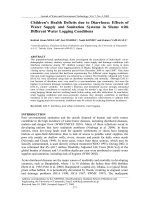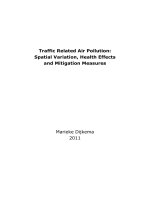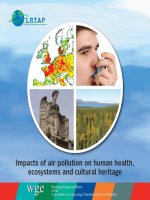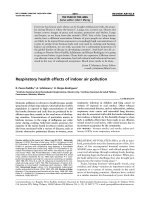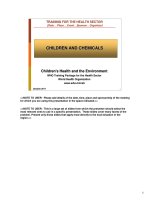INDOOR AIR POLLUTION - Children''''s Health and the Environment potx
Bạn đang xem bản rút gọn của tài liệu. Xem và tải ngay bản đầy đủ của tài liệu tại đây (1.64 MB, 67 trang )
1
INDOOR AIR POLLUTION
Children's Health and the Environment
WHO Training Package for the Health Sector
World Health Organization
www.who.int/ceh
TRAINING FOR THE HEALTH SECTOR
TRAINING FOR THE HEALTH SECTOR
[Date
[Date
…
…
Place
Place
…
…
Event
Event
…
…
Sponsor
Sponsor
…
…
Organizer]
Organizer]
July 2008 version
<<NOTE TO USER: Please add details of the date, time, place and sponsorship of the
meeting for which you are using this presentation in the space indicated.>>
<<NOTE TO USER: This is a large set of slides from which the presenter should
select the most relevant ones to use in a specific presentation. These slides cover
many facets of the problem. A number of slides refer to the specific issues related to
indoor air pollution in developing countries, as it represents a major determinant of
the burden of disease in children. Present only those slides that apply most directly
to the local situation in the region.>>
2
Indoor Air Pollution
Indoor Air Pollution
LEARNING OBJECTIVES
LEARNING OBJECTIVES
TO UNDERSTAND, RECOGNIZE AND KNOW:
TO UNDERSTAND, RECOGNIZE AND KNOW:
Hazards of indoor air pollution to children’s health
Different toxicants in indoor air, according to sources, settings
and activities
Characteristics and issues relating to indoor air pollution in
industrialized and developing countries
How to recognize, assess and address health effects
How to prevent exposure to indoor air contaminants
<<READ SLIDE>>
3
Indoor Air Pollution
Indoor Air Pollution
OUTLINE
OUTLINE
Scope of the problem of indoor air pollution
Scope of the problem of indoor air pollution
Particulate matter
Particulate matter
Carbon monoxide
Carbon monoxide
Secondhand
Secondhand
tobacco smoke
tobacco smoke
Pesticides
Pesticides
Solvents
Solvents
Volatile organic compounds
Volatile organic compounds
Biological pollutants
Biological pollutants
-
-
Mites
Mites
-
-
Allergens
Allergens
-
-
Moulds
Moulds
Built environment
Built environment
Radon
Radon
Asbestos
Asbestos
Occupation
Occupation
-
-
related contaminants
related contaminants
<<READ SLIDE>>
<<NOTE TO USER: When selecting the slides to include in your presentation, please choose
only those of relevance to the region/country and/or the interests of your audience.>>
The indoor contaminants addressed in this module include:
•Particulate matter
•Carbon monoxide
•Secondhand tobacco smoke
•Pesticides
•Solvents
•Volatile organic compounds
•Biological pollutants
- Mites
- Allergens
- Moulds
•Built environment
•Radon
•Asbestos
•Occupation-related contaminants
4
Indoor Air Pollution
Indoor Air Pollution
CHILDREN
CHILDREN
’
’
S UNIQUE VULNERABILITY
S UNIQUE VULNERABILITY
Inhale more pollutants per kilogram of body weight than
Inhale more pollutants per kilogram of body weight than
do adults
do adults
Because airways are narrower, irritation can result in
Because airways are narrower, irritation can result in
proportionately greater airway obstruction
proportionately greater airway obstruction
WHO
Infants and young children have a higher resting metabolic rate and rate of oxygen
consumption per unit body weight than adults because they have a larger surface area per
unit body weight and because they are growing rapidly. Therefore, their exposure to any air
pollutant may be greater.
In addition to an increased need for oxygen relative to their size, children have narrower
airways than do adults. Thus, irritation caused by air pollution that would produce only a
slight response in an adult can result in potentially significant obstruction in the airways of a
young child.
Ref:
•Moya J et al. Children’s behavior and physiology and how it affects exposure to
environmental contaminants. Pediatrics, 2004, 113:996.
•American Academy of Pediatrics Committee on Environmental Health. Pediatric
Environmental Health, 2
nd
ed. Etzel RA, Ed. Elk Grove Village, IL: American Academy of
Pediatrics, 2003.
•Children's Health and the Environment – A global perspective. A resource guide for the
health sector, WHO, 2005.
5
Indoor Air Pollution
Indoor Air Pollution
SMALLER AIRWAYS MORE VULNERABLE
SMALLER AIRWAYS MORE VULNERABLE
www.vh.org/pediatric/provider/pediatrics/ElectricAirway/Diagrams/AirwayDIaneterEdema.jpg
The effect of oedema on the adult airway is much less dramatic than it is on the newborn’s
airway. One millimetre of oedema reduces the diameter of the adult airway by about 19%
whereas it reduces the diameter of the infant airway by 56%.
Compared to that of adults, the peripheral airway (bronchioles) is both relatively and
absolutely smaller in infancy allowing intralumenal debris to cause proportionately greater
obstruction. In addition, infants have relatively larger mucous glands, with a concomitant
increase in secretions. They also have the potential for increased oedema because their
airway mucosa is less tightly adherent. Lastly, there are fewer interalveolar pores (Kohn’s
pores) in the infant, producing a negative effect on collateral ventilation and increasing the
likelihood of hyperinflation or atelectasis.
The resting minute ventilation normalized for body weight in a newborn infant (400
cc/min/kg) is more than double that of an adult (150 cc/min/kg).
Ref:
•Bar-on ME et al. Bronchiolitis. Prim Care, 1996, 23:805-19.
Picture:
www.vh.org/pediatric/provider/pediatrics/ElectricAirway/Diagrams/AirwayDIaneterEdema.jpg
- Copyright protected material used with permission of the authors: Drs. Michael and Donna
D'Alessandro - and the University of Iowa's Virtual Hospital, www.vh.org
6
Indoor Air Pollution
Indoor Air Pollution
DEPOSITION OF POLLUTANTS IN RESPIRATORY TRACT
DEPOSITION OF POLLUTANTS IN RESPIRATORY TRACT
CDC
Respirable particles and gases affect different parts of the respiratory tree depending upon
their inherent characteristics. For gases, relative solubility is important. For particles, size is
important.
This slide shows the upper, middle and lower respiratory tract. Note that sulfur dioxide,
because it is highly water soluble, initially affects the upper airway, whereas ozone, which
has medium solubility, initially affects the middle airways, and nitrogen dioxide, which has
low solubility, initially affects the lower airways.
7
Indoor Air Pollution
Indoor Air Pollution
SIZE MATTERS
SIZE MATTERS
Coarse particles (2.5
Coarse particles (2.5
–
–
10
10
micrometres
micrometres
) deposited in
) deposited in
the upper respiratory tract
the upper respiratory tract
and large airways
and large airways
Fine particles (< 2.5
Fine particles (< 2.5
micrometres
micrometres
) may reach
) may reach
terminal bronchioles and
terminal bronchioles and
alveoli
alveoli
Particle size is the most important factor in determining where particles are deposited in the
lung.
Compared with large particles, fine particles can remain suspended in the atmosphere for
longer periods and be transported over longer distances.
Some studies suggest that fine particles have stronger respiratory effects in children than
large particles.
This diagram shows that particles greater than 10 micrometres rarely make it past the upper
airways, whereas fine particles smaller than 2 micrometres can make it as far as the alveoli.
Ref:
•World Health Organization. Air Quality Guidelines. Geneva, World Health Organization:
Department of Protection of the Human Environment, 2005.
8
Indoor Air Pollution
Indoor Air Pollution
RESPIRATORY DEVELOPMENT:
RESPIRATORY DEVELOPMENT:
CONTINUES THROUGH LINEAR GROWTH
CONTINUES THROUGH LINEAR GROWTH
10 X 10
6
Alveoli
300 X 10
6
Alveoli
(age 8)
Growth/structure
•
Second-hand
tobacco smoke
• Particulates
• Ozone
Function
•
Indoor air quality
• Ambient ozone
Dieter,t 2000
2 to 8
2 to 8
Like the nervous system, the respiratory system continues to grow and develop through
linear growth. The upper section of the diagram depicts the different developmental phases
of the lungs corresponding to the age of the embryo/fetus. It may be seen that at birth, a
baby has about 10 million alveoli, but at age 8 years, the lungs have grown and the number
of alveoli has reached 300 million. Exposures during this growth period are known to have
adverse consequences on both structure (growth of the lungs, as illustrated in the diagram)
and function (which is affected by indoor air quality and ozone exposure).
Figure: Dietert RR et al. Workshop to identify critical windows of exposure for children's
health: immune and respiratory systems – work group summary. Environmental Health
Perspectives, 2000, 108:483-90. Reproduced with permission from Environmental Health
Perspectives
9
Indoor Air Pollution
Indoor Air Pollution
0 20000 40000 60000 80000 100000 120000 140000 160000
Underweight
Unsafe water, sanitation and hygiene
Indoor smoke from solid fuels
Zinc deficiency
Vitamin A deficiency
Iron deficiency
Unsafe sex
Lead exposure
Climate change
Unsafe health care injections
Ambient air pollution
Alcohol
Illicit drugs
Attributable burden of disease 0–4 years
1000 DALY
World Health Report 2002
In analyses by the World Health Organization (WHO) in 2002, the indoor smoke from solid
fuels accounted for the third highest disability-adjusted life years (DALYs) for children 0 to 4
years of age.
The DALY is a health measure that incorporates loss of quality of life as well as loss of years
of life. One DALY is the loss of one healthy life year.
Ref:
•World Health Report 2002 (www.who.int/whr/2002/en/).
Picture: World Health Report 2002
10
Indoor Air Pollution
Indoor Air Pollution
CHILDREN
CHILDREN
’
’
S INDOOR EXPOSURE
S INDOOR EXPOSURE
Level of economic development is a key factor
Level of economic development is a key factor
Developing and industrialized countries
Developing and industrialized countries
Rural and urban areas
Rural and urban areas
Local climate
Local climate
Architecture/ventilation
Architecture/ventilation
In urban areas, children
In urban areas, children
may spend most of their time indoors.
may spend most of their time indoors.
Most
Most
exposure to air contaminants occurs
exposure to air contaminants occurs
inside homes and schools.
inside homes and schools.
WHO
<<READ SLIDE>>
The level of economic development is a key factor in determining children’s exposures and
the potential for responding to or improving their environment.
The level of social and economic development is linked closely to determinants of indoor air
pollution (IAP).
There are major differences between developing and industrialized countries: IAP results
from solid fuel use in the former, and from "chemicals" and "new substances" (e.g.
formaldehyde, insecticides and phthalates) in the latter. However, secondhand tobacco
smoke is a pollutant common to both settings.
IAP also differs between rural and urban areas due to the different economies and lifestyles.
For example, dust and organic particles are more common in agricultural areas and mites or
fungal contaminants in closed, unventilated urban dwellings.
The local climate conditions should also be taken into consideration, as they have an impact
on architecture (building materials used, structure, room distribution and characteristics) and
– particularly – on the ventilation of the dwelling.
Children in urban areas spend most of their time indoors, which means that their primary
exposure to air pollution may come from air inside homes and schools rather than outdoors.
There are numerous situations in homes and schools which may result in possible exposure
to contaminants, such as second-hand tobacco smoke, spraying of insecticides,
accumulation of pollutants in carpets, poor quality air and others. Children may also be
exposed where they play or at workplaces. The quality of children’s environments can cause
or prevent illness, disability and injury.
Picture: WHO.
11
Indoor Air Pollution
Indoor Air Pollution
INDOOR AIR QUALITY
INDOOR AIR QUALITY
Indoor air quality is influenced
Indoor air quality is influenced
by
by
:
:
Outdoor air pollution: vehicles and industrial plants
Secondhand tobacco smoke
Fuels used for heating and cooking
Confined and poorly ventilated spaces
Overcrowded homes and insufficient living space
Customs, habits, traditions
Level of economic development:
Industrialized ≠ developing countries
Indoor air quality is influenced by concentrations of outdoor air pollutants, indoor sources of
pollution, characteristics of the building and the habits of the residents.
Indoor air pollution may arise from the use of open fires, unsafe fuels or combustion of
biomass fuels, coal and kerosene. Gas stoves or badly installed wood-burning units with
poor ventilation and maintenance can increase the indoor levels of carbon monoxide,
nitrogen dioxide and particles.
Other pollutants not associated with fuel combustion include building materials such as
asbestos and cement, wood preservatives and others.
Volatile organic compounds may be released by various sources including paints, glues,
resins, polishing materials, perfumes, spray propellants and cleaning agents. Formaldehyde
is a component of some household products and can irritate the eyes, nose and airways.
12
Indoor Air Pollution
Indoor Air Pollution
2 000 000 deaths from ARI in
< 5 yr olds (½ due to solid fuel
use)
Rising trends of “wheezing”
Coal and biomass fuel: a major source of indoor air pollution
Suspended particulate matter increases the risk of acute respiratory infections
CO and other toxic gases may impair development and health
Secondhand tobacco smoke a major concern
HOMES OF POOR CHILDREN MAY BE UNHEALTHY
HOMES OF POOR CHILDREN MAY BE UNHEALTHY
WHO
The home is the first indoor environment a child will know. It should be a safe and healthy
place. But the homes of poor children may be unhealthy places.
ARI = acute respiratory illness
CO = carbon monoxide
<<READ SLIDE.>>
Picture: WHO, C. Gaggero. Child housework, Costa Rica.
13
Indoor Air Pollution
Indoor Air Pollution
ADVERSE HEALTH EFFECTS OF AIR POLLUTANTS
ADVERSE HEALTH EFFECTS OF AIR POLLUTANTS
Acute:
Acute:
Irritation of the mucous membranes (eyes, nose, throat)
Cough, wheeze, chest tightness
Increased airway responsiveness to allergens
Increased incidence of acute respiratory illness:
"cold", pneumonia, otitis media
Tracheobronchitis
Exacerbation of asthma
<<READ SLIDE.>>
14
Indoor Air Pollution
Indoor Air Pollution
ADVERSE HEALTH EFFECTS OF AIR POLLUTANTS
ADVERSE HEALTH EFFECTS OF AIR POLLUTANTS
Chronic
Chronic
:
:
Long-term exposure decreases lung growth
Impairment of pulmonary function
Increased susceptibility to chronic obstructive lung
diseases, including asthma
Other
<<READ SLIDE.>>
15
Indoor Air Pollution
Indoor Air Pollution
ENVIRONMENT AND POLLUTION
ENVIRONMENT AND POLLUTION
Indoor environments also reflect
Indoor environments also reflect
outdoor
outdoor
air quality
air quality
Industrial or agricultural activities
Treatment of industrial effluents and domestic residues
Traffic
Solid waste management
Cottage industries
Chemical incidents and spills
WHO
The indoor environment also reflects outdoor air quality and pollution. Outdoor pollution
primarily results from the combustion of fossil fuels by industrial plants and vehicles. This
releases carbon monoxide, sulfur dioxide, particulate matter, nitrogen oxides, hydrocarbons
and other pollutants. The characteristics of emissions and solid waste disposal may vary for
each specific industry (e.g. smelting, paper production, refining and others).
Picture: WHO, J. Vizcarra. Environmental Air Pollution
16
Indoor Air Pollution
Indoor Air Pollution
INDOOR AIR POLLUTION ALSO AFFECTS OUTDOOR AIR
INDOOR AIR POLLUTION ALSO AFFECTS OUTDOOR AIR
QUALITY
QUALITY
Nigel Bruce/ITDG
Indoor smoke polluting the ambient air in a small village in Nepal.
Picture: Nigel Bruce/ITDG. Used with permission.
17
Indoor Air Pollution
Indoor Air Pollution
COMBUSTION PRODUCTS
COMBUSTION PRODUCTS
Sources
Sources
Gas stoves and appliances
Wood and coal stoves
Gas and propane engines
Fireplaces
Tobacco smoke
Candles and incense
Mosquito coils
Combustion products
Combustion products
Carbon monoxide (CO)
Nitrogen dioxide (NO
2
)
Sulfur dioxide (SO
2
)
Nitrogenated compounds (NO
x
)
Particulate matter (PM)
A large number of combustion products originate from various different sources. The main
ones are listed here.
<<READ SLIDE.>>
18
Indoor Air Pollution
Indoor Air Pollution
SMOKY COOKING FUELS
SMOKY COOKING FUELS
Open fire cooking stoves produce heavy smoke containing:
Open fire cooking stoves produce heavy smoke containing:
Fine particles
Carbon monoxide (CO)
Polycyclic aromatic hydrocarbons (PAHs)
Strongly linked to pneumonia
Suggested link to low birth weight
In adults: chronic obstructive
pulmonary disease, lung cancer
WHO
<<READ SLIDE>>
Girls are at most risk as they are often requested to help their mothers with household
chores. Infants are exposed to pollutants when carried on the backs of their mothers as they
tend fires. Irritation that would not affect adults may result in severe obstruction or damage to
children’s lungs because they are more vulnerable.
Ref:
•Environmental threats to children. In: Children in the New Millennium, Environmental Impact
on Health. UNEP, UNICEF & WHO, 2002.
•Smith KR et al. Chapter 18: Indoor smoke from household use of solid fuels. In: Ezzati Eds.
Comparative quantification of health risks: The global burden of disease due to selected risk
factors, Vol 2. Geneva: World Health Organization, 2004.
19
Indoor Air Pollution
Indoor Air Pollution
HOUSEHOLD ENERGY, IAP AND HEALTH
HOUSEHOLD ENERGY, IAP AND HEALTH
3 billion people rely on solid fuels
Solid fuels comprise 10 15% of the
total fuels used worldwide
Cooking and heating
levels indoor air pollution
Most concern: particulate matter and
carbon monoxide
Women and children heavily exposed
Dung
Wood
Agricultural
residues
Charcoal
Coal
Nigel Bruce/ITDG
Some 3 billion people (half of the world’s population!) rely on solid fuels (e.g. dung, wood,
agricultural residues, charcoal, coal) for their basic energy needs.
Cooking and heating with solid fuels leads to high levels of indoor air pollution (IAP), a
complex mix of health-damaging pollutants (e.g. particulate matter and carbon monoxide).
Women and young children, who spend most time at home, experience the largest
exposures and health burdens.
IAP = indoor air pollution
Picture: Nigel Bruce/ITDG. Used with permission.
20
Indoor Air Pollution
Indoor Air Pollution
Level of particulates in home
using biofuel: >1000 µg/m
3
(24 hr mean)
Can reach 10 000 µg/m
3
PM
10
(if
using an open fire)
EPA: 50 µg/m
3
PM
10
annual mean
Women and young children have
greatest exposure
INDOOR AIR POLLUTION LEVELS ARE VERY HIGH
INDOOR AIR POLLUTION LEVELS ARE VERY HIGH
Nigel Bruce/ITDG
Standards and guidelines
US EPA standards are illustrated here. 150 µg/m
3
PM
10
is the 24-hour 99% percentile value, thus it
should be exceeded only on 1% of occasions. The recommended annual mean limit is 50 µg/m
3
PM
10
(PM
10
are respirable particles ≤ 10 micrometre (µm) in diameter).
Levels of pollution in homes using biomass fuel
Numerous studies have shown that the levels of particulates are very high, with 24-hour means of around
1000 µg/m
3
PM
10
, and even exceeding 10 000 µg/m
3
PM
10
when sampling is carried out during use of an
open fire. It is reasonable to compare the EPA recommended annual mean limit of 50 µg/m
3
PM
10
with
the typical 24-hour mean for a home in which biomass fuel is used, of 1000 µg/m
3
PM
10
quoted, as this
latter value is typical of the level every day (thus, annual mean levels can be expected to be around 1000
µg/m
3
PM
10
). This comparison shows that average pollution levels are around 20 times the EPA
recommended limit.
Ambient pollution and personal exposure
Two important components are (a) the level in the home, and (b) the length of time for which each person
in the home is exposed to that level. We know that typically women and young children (until they can
walk), and girls (as they learn kitchen skills) are often exposed for at least 3–5 hours a day, often more. In
some communities, and where it is cold, exposure will be for a much longer period each day.
Ref:
•Addressing the links between indoor air pollution, household energy and human health. Based on the
WHO-USAID Consultation on the Health Impact of Household Energy in Developing Countries (Meeting
report).Geneva, World Health Organization, 2002.
Additional information can be found at: www.who.int/indoorair/publications/en/
Picture: Courtesy of Nigel Bruce/ITDG. Used with permission.
21
Indoor Air Pollution
Indoor Air Pollution
Gordon, WHO, 2004
Cooking is central to our lives, yet the very act of cooking is a threat to children’s health and
well-being. Half of the world’s population relies on solid fuels, such as dung, wood, crop
waste or coal to meet their most basic energy needs. In most developing countries, these
fuels are burned in open fires or rudimentary stoves that give off black smoke. Children,
often carried on their mother’s back during cooking, are most exposed. The indoor smoke
inhaled leads to pneumonia and other respiratory infections – the biggest killer of children
under 5 years of age. Indoor air pollution is responsible for nearly half of the more than 2
million deaths each year that are caused by acute respiratory infections. Good ventilation
and improved cooking stoves can dramatically reduce children’s exposure to smoke.
Ultimately, making the transition to gas and electricity will save lives and reduce the physical
toll on women and children from gathering wood, freeing time for education and
development. This problem has been largely ignored by policy-makers.
Ref:
•Gordon B et al. Inheriting the world, the Atlas on Children's Health and the Environment.
Geneva, World Health Organization, 2004
22
Indoor Air Pollution
Indoor Air Pollution
AGE DISTRIBUTION OF GLOBAL BURDEN OF DISEASE
AGE DISTRIBUTION OF GLOBAL BURDEN OF DISEASE
ATTRIBUTABLE TO SOLID FUEL USE
ATTRIBUTABLE TO SOLID FUEL USE
A g e
g ro u p
(y rs )
A ttr ib u ta b le
m o rta lity
A ttr ib u ta b le
D A L Y s
0 – 4 5 6 8 3
5 – 1 4 0 0
1 5 – 5 9 5 8
6 0 + 3 8 9
Young children at high risk due to:
Lung immaturity
High exposure to IAP: nearly 1 million
children under 5 yrs die every year due to
solid fuel use!
WHO
DALY = disability-adjusted life year. The DALY is a health measure that incorporates loss of
quality of life as well as loss of years of life. One DALY is the loss of one healthy life year.
IAP = indoor air pollution
Ref:
•The health effects of indoor air pollution exposure in developing countries. Concise
summary of the evidence for health effects of exposure to indoor air pollution from solid fuel
use in children and adults. Geneva, World Health Organization, 2002.
•Indoor air pollution: national burden of disease estimates. Geneva, World Health
Organization, 2007.
•Fuel for life: household energy and health. Geneva, World Health Organization, 2006.
•Indoor air pollution from solid fuels and risk of low birthweight and stillbirth. Geneva, World
Health Organization, 2007.
•Indoor air pollution and respiratory tract infections in children. Geneva, World Health
Organization, 2007.
Additional information on these references can be found at:
www.who.int/indoorair/publications/en/
Picture: WHO. Americas.
23
Indoor Air Pollution
Indoor Air Pollution
Lead
Lead
Lead
Lead
Climate change
Climate change
Percent
Percent
age
age
of total
of total
burden
burden
(within region)
(within region)
1%
1%
-
-
5%
5%
-
-
Water, sanitation and hygiene (5.5%)
Water, sanitation and hygiene (5.5%)
Underweight
Underweight
Solid fuel use (3.7 %)
Solid fuel use (3.7 %)
Ambient air
Ambient air
Occupational injuries
Occupational injuries
Developing countries
Developing countries
(high mortality)
(high mortality)
Industrialized countries
Industrialized countries
Occupational risks
Occupational risks
Alcohol
Alcohol
Tobacco
Tobacco
Overweight
Overweight
Unsafe sex
Unsafe sex
Tobacco
Tobacco
Alcohol
Alcohol
Ambient air
Ambient air
Water, sanitation and hygiene
Water, sanitation and hygiene
Overweight
Overweight
Unsafe sex
Unsafe sex
Physical
Physical
inactivity
inactivity
Zinc deficiency
Zinc deficiency
GLOBAL BURDEN OF DISEASE ATTRIBUTABLE TO
GLOBAL BURDEN OF DISEASE ATTRIBUTABLE TO
SELECTED MAJOR RISK FACTORS
SELECTED MAJOR RISK FACTORS
Household energy practices vary widely around the world, as does the resultant death toll
due to indoor smoke. In high-mortality developing countries, indoor smoke is responsible for
3.7% of the overall disease burden, making it the most important risk factor after malnutrition
(9%), unsafe sex (6%) and lack of safe water and adequate sanitation. In low-mortality
developing countries, indoor smoke occupies the 8
th
rank and accounts for 1.9% of the
disease burden. In contrast, in industrialized countries the impact of cooking and heating
with solid fuels becomes negligible in relation to risk factors such as tobacco, high blood
pressure and alcohol consumption. Notes taken from
www.who.int/indoorair/info/en/briefing2.pdf
Refs:
•Indoor air pollution in developing countries: a major environmental and public health
challenge. Bulletin of the World Health Organization, 2000.
•World Health Report 2002. Indoor Air Thematic Briefing 2
(www.who.int/indoorair/info/en/briefing2.pdf).
Additional information can be found at: www.who.int/indoorair/publications/en/
24
Indoor Air Pollution
Indoor Air Pollution
WHAT INTERVENTIONS ARE AVAILABLE TO REDUCE
WHAT INTERVENTIONS ARE AVAILABLE TO REDUCE
INDOOR AIR POLLUTION FROM SOLID FUELS?
INDOOR AIR POLLUTION FROM SOLID FUELS?
-
-
Fuel drying
Fuel drying
-
-
Use of pot lids
Use of pot lids
-
-
Good
Good
maintenance
maintenance
-
-
Keeping children
Keeping children
away from smoke
away from smoke
-
-
Hoods and chimneys
Hoods and chimneys
-
-
Windows, ventilation
Windows, ventilation
holes, eaves spaces
holes, eaves spaces
-
-
Separate kitchen
Separate kitchen
-
-
Improved stoves
Improved stoves
-
-
Cleaner fuels
Cleaner fuels
(kerosene, gas,
(kerosene, gas,
electricity)
electricity)
User
User
behaviour
behaviour
Home
Home
environment
environment
Source of pollution
Source of pollution
<<READ SLIDE>>
Solid fuels comprise only 10–15% of fuel used.
•Nearly one half of the world’s population uses solid fuels for cooking and heating homes.
- 2 billion people are exposed to particulate matter (PM) and gases at levels up to 100 times
higher than in ambient (outdoor) air.
- Women and children are most exposed: levels may be 10 to 100 times above safety
standards for ambient air.
Combustion produces hundreds of toxic chemicals that concentrate inside homes.
Biomass (wood, agricultural produce, straw and dung) produces:
- a wide variety of liquids, suspended particles, gases and mixtures.
Coal produces:
- Polycyclic aromatic hydrocarbons (PAHs), benzene, formaldehyde, sulfur, heavy metals
and fluoride.
These pollutants affect the most vulnerable populations, women of childbearing age, infants
and children in the poorest circumstances.
Ref:
Air pollution: what a paediatrician needs to know. Leaflet published by the World Health
Organization in collaboration with the International Pediatric Association, 2003.
Additional information on these references can be found at:
www.who.int/indoorair/publications/en/
25
Indoor Air Pollution
Indoor Air Pollution
CARBON MONOXIDE: THE "SILENT KILLER"
CARBON MONOXIDE: THE "SILENT KILLER"
A COMMON CAUSE OF ACUTE AND LETHAL POISONING
A COMMON CAUSE OF ACUTE AND LETHAL POISONING
Colourless, odourless gas formed by incomplete burning of
carbon-based fuels
CO’s affinity for Hb is 240
–
–
270 times greater than oxygen
Fetal Hb has higher affinity for CO
CO causes a leftward shift of the
oxyhaemoglobin (OHb) dissociation curve
Intoxication results in tissue hypoxia
Multiple organ systems are affected
www.cdc.gov/nceh/airpollution/carbonmonoxide/checklist.htm
• CO is a colourless, odourless gas formed by incomplete burning of carbon-based fuels.
• CO’s affinity for haemoglobin (Hb) is 240–270 times greater than that of oxygen:
- it decreases the capacity of Hb for carrying oxygen.
• Fetal Hb has a higher affinity for CO.
• CO causes a leftward shift of the oxyhaemoglobin dissociation curve:
- it decreases oxygen delivery to tissues.
• Intoxication results in tissue hypoxia.
• Multiple organ systems are affected:
- Mainly systems with high metabolic rates;
- CNS, cardiovascular system.
Exposure to carbon monoxide reduces the blood's ability to carry oxygen. The chemical is
odourless and some of the symptoms of exposure are similar to those of common illnesses.
This is particularly dangerous because carbon monoxide's deadly effects may not be
recognized until it is too late to take action.
Exposure to carbon monoxide is particularly dangerous to unborn babies, infants and people
with anaemia or a history of heart disease. Breathing low levels of the chemical can cause
fatigue and increase chest pain in people with chronic heart disease. Breathing higher levels
of carbon monoxide causes symptoms such as headaches, dizziness and weakness in
healthy people. Carbon monoxide also causes sleepiness, nausea, vomiting, confusion and
disorientation. At very high levels it causes loss of consciousness and death. Poisoning may
have irreversible sequelae.
These notes are taken from the US EPA website www.epa.gov/iaq/co.html
Hb = haemoglobin
COHb = carboxyhaemoglobin
Refs:
•
Carbon monoxide. In:
Pediatric Environmental Health, 2nd ed. Etzel RA Ed. Elk Grove
